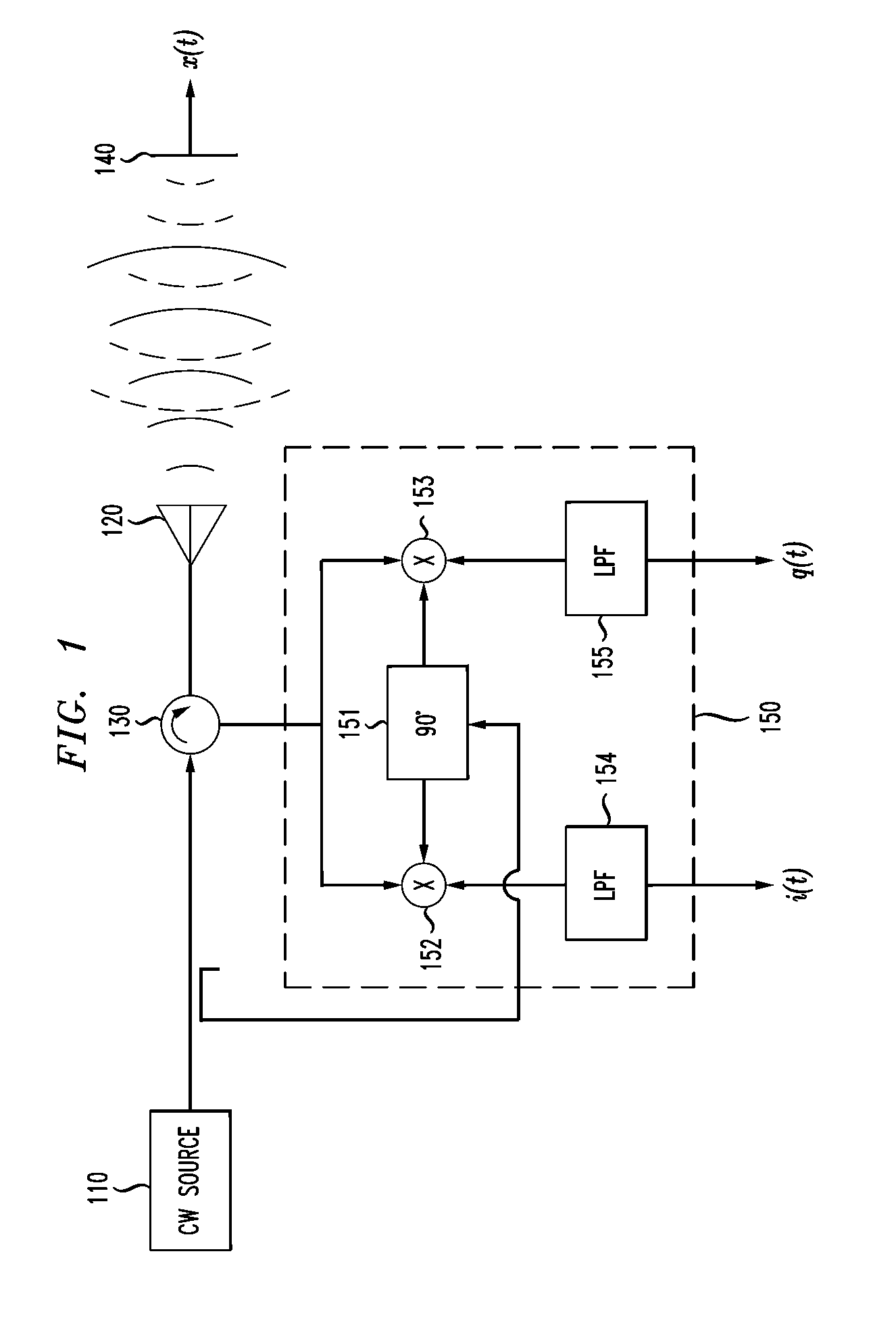Doppler Radar Cardiopulmonary Sensor and Signal Processing System and Method for Use Therewith
a cardiopulmonary and heart rate sensor technology, applied in the field of signal processing, can solve problems such as difficult reliable heart rate estimation and even more difficult problems
- Summary
- Abstract
- Description
- Claims
- Application Information
AI Technical Summary
Problems solved by technology
Method used
Image
Examples
experiment 1
C. Experiment 1
Subject Stationary at 1 m from Antenna, Remaining Still and Holding Breath
[0125]In the first experiment, the subject is seated at a distance of 1 m from the antenna and holds his breath so that no interference from respiration occurs. FIGS. 14A-C show plots of the raw I and Q signals (FIGS. 14A and B), along with the reference pulse signal (FIG. 14C). The heartbeat signal is apparent, which is strongly correlated with the reference signal. FIG. 14D shows the arc-length signal calculated from Equation (4), which optimally combines the I and Q signals.
[0126]The spectrum of the arc-length signal is plotted in FIG. 14F, which also displays the estimated respiration and heart rates (solid vertical lines), as well as the actual heart rate (dashed vertical line) from the reference signal. (In this case, the estimated respiration rate is probably spurious since the subject is purposely holding his breath. Also, the dashed line is obscured in this case since the estimated hear...
experiment 2
Subject Stationary at 1 m from Antenna, Remaining Still and Breathing Regularly
[0127]In Experiment 2, the same subject is seated in the same position, but is now breathing in a regular manner. FIGS. 15A-F display the same information as FIGS. 14A-F for Experiment 1. Comparing the two, FIG. 15A-C show that the respiration component is now dominant and the heartbeat component is difficult to see. The respiration rate is roughly 5 cycles over 20 s, or 15 bpm. Comparing FIG. 15D with FIG. 14D shows that the peak-to-peak heartbeat component in the former is roughly 0.015 V as compared to a peak-to-peak respiration component of about 0.3 V in the latter, i.e., a ratio of 1:20 or 26 dB. FIG. 15C can also be compared to the test signal of FIG. 7C, showing much similarity.
[0128]As compared to FIG. 14F, the power spectrum of FIG. 15F is now cluttered with many respiration harmonics, making it difficult to decide which peak corresponds to the heartbeat component. Indeed, the heart-rate estimat...
experiment 3
E. Experiment 3
Subject Reciprocating at 1 m from Antenna and Breathing Regularly
[0131]Experiment 3 introduces movement for the first time. Now the same subject is standing 1 m in front of the antenna, and slowly takes one step forward, one step back, one step back, and one step forward, with the same foot moving in both directions, the other foot immobile, and a slight pause after each move. The subject repeats this four-move reciprocating cycle about 3½ times over the 20 s data collection period. The I / Q and reference data are plotted in FIG. 17A-C. In comparison with the still data of Experiments 1 and 2 shown in FIGS. 14A-C and 15A-C, large sinusoidal variations corresponding to the motion over many λ / 2 (6.25 cm at 2.4 GHz) Doppler cycles are apparent. For this example, about nine cycles exist from trough to peak and from peak to trough, corresponding to a peak-to-peak motion of 9×6.25 cm≈0.56 m. Thus, considering the nominal 1 m distance to the antenna, the range varies from abo...
PUM
 Login to View More
Login to View More Abstract
Description
Claims
Application Information
 Login to View More
Login to View More - R&D
- Intellectual Property
- Life Sciences
- Materials
- Tech Scout
- Unparalleled Data Quality
- Higher Quality Content
- 60% Fewer Hallucinations
Browse by: Latest US Patents, China's latest patents, Technical Efficacy Thesaurus, Application Domain, Technology Topic, Popular Technical Reports.
© 2025 PatSnap. All rights reserved.Legal|Privacy policy|Modern Slavery Act Transparency Statement|Sitemap|About US| Contact US: help@patsnap.com



